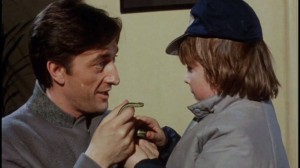Valeria Golino’s Miele establishes itself perfectly with its opening scene. After hearing a woman speaking with a client of some sort from behind a gorgeous, seemingly-reflective design, the camera pulls away to reveal actress Jasmine Trinca stepping out of a room and into a quiet, secluded hallway. She sits, listens to her own music, and waits, almost reveling in the loneliness to ease her mind after whatever situation she’s faced. It is only soon after that we realize why she finds comfort in the silence. Although one would never decipher it from her look, Irene is a new-age Jack Kevorkian. Her nickname Miele is fitting; honey helps the medicine go down easier, just as her work is to help ease the suffering into the next world.
To imagine anyone willing to take on a role such as hers is baffling, even as she stands like the Angel of Death in the room, waiting for those she assists to exit this world to the tune of their chosen music. And the film doesn’t side-step this one bit. “What a shitty job you have,” a client’s sister bluntly states, but what Golino and co-writers Francesca Marciano and Valia Santella show in Irene is a genuine longing to help. Adding to that is the way the film presents everything matter-of-factly. Her nude body (more a baring of soul than anything sensuality) and the deaths of the many people she helps are never shown through any sort of exploitative lens. It’s all presented through as caring a scope as the character it’s investigating. If anything, it shows a never-ceasing sense of heartache. Her interactions with Carlo, a depressed client — one she is initially hesitant towards due to his lack of a terminal illness — are what shows this best, as well as what drives the film’s narrative. But as much as the film grounds itself in the relationship between Irene and Carlo rather than any of her other clients, Miele is a tale best told through its visuals.
Pairing Gergely Pohárnok’s beautifully realistic cinematography with Trinca’s ability to emote every single emotion on cue provides amazing results for Miele. The dialogue written for Irene and her client Carlo is sometimes lacking, but it all comes together in the way the camera catches the smiles, the stoic looks, and the tears she delivers. She finds a certain sense of comfort in isolation, in a world where she doesn’t have to aid those looking to take a step into the next realm. It doesn’t matter if she’s surrounded by people at a club, enjoying the sexual company of a man she’s seeing, or simply spending time with her father, Golino always emphasizes how much Irene is kept at a distance from the world around her. But it is Carlo’s mere presence in her life that offers a change from everything she once found solace in. As predictable as that idea of one person changing so much in another’s life may sound, it works for developing Irene’s character appropriately, allowing her to reach her own realizations without the input of another ever seeming overbearing. It’s in the silence that she finds solace, and in no way is that notion ever betrayed.
In an often quiet, beautiful way, Miele reflects on the peace we find in death, as well as the comfort those we leave behind find in knowing that there’s joy to be found in death. For her feature debut, actress-turned-director Valeria Golino shows a lot of promise by creating an interesting film that offers introspection into such an unusual but fascinating woman. One can only hope that whatever comes next for both her and Jasmine Trinca will prove just as good, if not better.
—
Miele played in Miami at the Miami Beach Cinematheque and the Cosford Cinema and is currently available for pre-order on DVD for January 6, 2015.
Directed by Valeria Golino; written by Valeria Golino, Francesca Marciano, and Valia Santella; adapted from Mauro Covacich’s novel A nome tuo; starring Jasmine Trinca and Carlo Cecchi; 96 minutes.




 Derek
Derek
 Isabelle
Isabelle